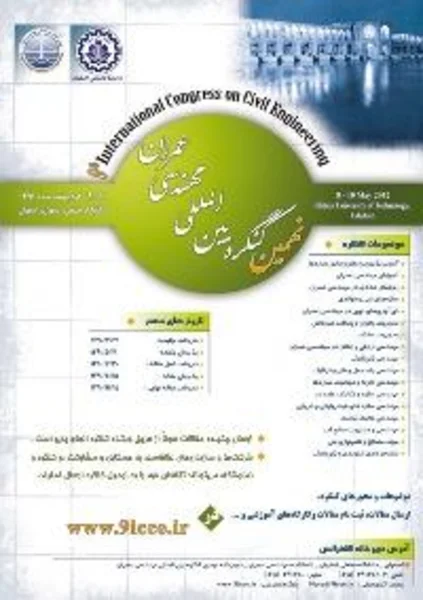-
a computational study on shell surface with curved folds in the form of fibonacci spiral
جزئیات بیشتر مقاله- تاریخ ارائه: 1390/11/15
- تاریخ انتشار در تی پی بین: 1390/11/15
- تعداد بازدید: 636
- تعداد پرسش و پاسخ ها: 0
- شماره تماس دبیرخانه رویداد: -
this research was carried out to investigate effect of curve folds in the form of fibonacci spiral on behaviour of folded shell structures. procedures to generate fibonacci spiral on the plan shape of shell surface with curved folds have been proposed. some of the fibonacci sequence numbers are 1, 1, 2, 3, 5, 8, 13, 21, 34, 55, 89, 144, 233, 377, 610, 987, 1597, … the procedures proposed starts with specification of a central square with edge length of 2 which is the third number in fibonacci sequence and ends when the spiral curve touches tangentially the edge of the outer square with length of 8 which is the sixth number in fibonacci sequence. two versions of models with different configuration of the spiral curves have been generated: one with constant radius of 3 (constant radius) and the second one with radius of 3 and 5 (variable radius). the resulting plan view of the generated shell surface with folds consists of four spiral curves emanating from each of the four corner of the center 2x2 square. finite element model is then generated for the purpose of structural analysis under self- weight using the software sap2000. pin support conditions at four intersection points along the outer edge have been assigned. internal forces and deflection have been checked to compare the structural behaviour of the two models mentioned earlier. results of analysis show that shell surface with spiral curved fold lines with variable radius has better performance as compared to that of constant radius. specifically, in terms of maximum tensile stress, shell surface with constant radius is 24.95% higher than the model with variable radius and also maximum compressive stress for shell surface with constant radius is 36.83% higher than the model with variable radius. in terms of deflection, maximum vertical displacement in model with constant radius and variable radius is approximately the same with difference of only 4%. model with constant radius shows maximum rotation which is 23.36% higher than that in model with variable radius.
مقالات جدیدترین رویدادها
-
استفاده از تحلیل اهمیت-عملکرد در ارائه الگوی مدیریت خلاقیت سازمانی و ارائه راهکار جهت بهبود
-
بررسی تاثیر ارزش وجوه نقد مازاد بر ساختار سرمایه شرکت های پذیرفته شده در بورس اوراق بهادار تهران
-
بررسی تأثیر سطح افشای ریسک بر قرارداد بدهی شرکت های پذیرفته شده در بورس اوراق بهادار تهران
-
بررسی تأثیر رتبه بندی اعتباری مبتنی بر مدل امتیاز بازار نوظهور بر نقد شوندگی سهام با تأکید بر خصوصی سازی شرکت ها
-
تأثیر آمیخته بازاریابی پوشاک ایرانی بر تصویر ذهنی مشتری پوشاک ایرانی (هاکوپیان)
-
سنجش میزان رضایت ساکنین از شاخص های کمی و کیفی مسکن مهر (نمونه موری: مسکن مهر شهر خرم آباد)
-
تاملی نو در مبانی فقهی وجوب حکم حجاب بانوان
-
تعیین پیکربندی بهینه میراگرهای فلزی در قاب فولادی با استفاده از روش تحلیل زمان دوام
-
energy bound for sign changing solutions of an asymptotically linear elliptic equation in rn
-
aggregation of nanoparticles in high ionic strength suspensions: effect of hamaker constant and particle concentration
مقالات جدیدترین ژورنال ها
-
مدیریت و بررسی افسردگی دانش آموزان دختر مقطع متوسطه دوم در دروان کرونا در شهرستان دزفول
-
مدیریت و بررسی خرد سیاسی در اندیشه ی فردوسی در ادب ایران
-
واکاوی و مدیریت توصیفی قلمدان(جاکلیدی)ضریح در موزه آستان قدس رضوی
-
بررسی تاثیر خلاقیت، دانش و انگیزه کارکنان بر پیشنهادات نوآورانه کارکنان ( مورد مطالعه: هتل های 3 و 4 ستاره استان کرمان)
-
بررسی تاثیر کیفیت سیستم های اطلاعاتی بر تصمیم گیری موفق در شرکتهای تولیدی استان اصفهان (مورد مطالعه: مدیران شرکتهای تولیدی استان اصفهان)
-
ارزیابی تأثیر ارتباطات سازمانی اثربخش بر بهبود خلاقیت سازمانی و شکل گیری همدلی سازمانی
-
استفاده صلح آمیز از انرژی هسته ای از منظر حقوق بین الملل با تاکید بر بیانات رهبری
-
کاربرد ابزار هوش مصنوعی در پیش بینی مصرف انرژی ساختمان
-
تأثیر تمرینات پیلاتس بر نیمرخ لیپیدی زنان غیر فعال دارای اضافه وزن
-
electrochemical sensors; types and applications in the food industry




سوال خود را در مورد این مقاله مطرح نمایید :